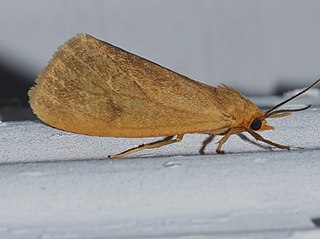
Tsuga is a genus of conifers in the subfamily Abietoideae of Pinaceae, the pine family. The common name hemlock is derived from a perceived similarity in the smell of its crushed foliage to that of the unrelated plant poison hemlock. Unlike the latter, Tsuga species are not poisonous.

Virbia is a genus of tiger moths in the family Erebidae. The genus was erected by Francis Walker in 1854.

Virbia aurantiaca, the orange holomelina, is a moth species of the family Erebidae found in North America. In the east it has been recorded from Manitoba and Nova Scotia, south along the eastern seaboard to Cordoba in Mexico. It has also been recorded from Texas, Mississippi, Missouri, Tennessee, Louisiana, Oklahoma, Kansas, North Dakota and South Dakota.
Virbia costata is a moth in the family Erebidae. It was described by Richard Harper Stretch in 1884. It is found in the western United States, ranging to western Oklahoma in the east and Colorado in the north.
Virbia esula is a moth in the family Erebidae. It was described by Herbert Druce in 1889. It is found in Mexico.
Virbia fergusoni is a moth in the family Erebidae. It was described by Jennifer M. Zaspel in 2008. It is found in the south-eastern United States, ranging to South Carolina in the north and from Georgia and northern Florida to Alabama in the west. The habitat consists of mixed oak-pine forests.
Virbia ferruginosa, the rusty holomelina, is a moth in the family Erebidae. It was described by Francis Walker in 1854. It is found from Nova Scotia to British Columbia in Canada. In the United States it is found from the northeast and upper Midwest, south to Virginia, Mississippi, Missouri and Louisiana.
Virbia fragilis is a moth in the family Erebidae. It was described by Strecker in 1878. It is found in open fields in the Black Hills in South Dakota and in Boulder, Colorado. The range extends north to Alberta and British Columbia and south to New Mexico.
Virbia hypophaea is a moth in the family Erebidae. It was described by George Hampson in 1901. It is found in Costa Rica and Brazil.
Virbia immaculata, the immaculate holomelina or plain-winged holomelina, is a moth in the family Erebidae. It was described by Tryon Reakirt in 1864. It is found from the eastern coast of North America west to Manitoba. It has also been recorded in Iowa, Illinois and Indiana.

Virbia laeta, the joyful holomelina, is a moth in the family Erebidae. It was described by Félix Édouard Guérin-Méneville in 1844. It is found in North America from New Brunswick south to Florida and west to Minnesota and south to Texas. The habitat consists of pine woodlands.
Virbia lamae, the bog holomelina, is a moth in the family Erebidae. It was described by Thomas Nesbitt Freeman in 1941. It is found in North America in Nova Scotia, New Brunswick, Maine, Wisconsin and Michigan. The habitat consists of open peat bogs.
Virbia mathani is a moth in the family Erebidae. It was described by Walter Rothschild in 1910. It is found in Colombia.
Virbia metazonata is a moth in the family Erebidae. It was described by George Hampson in 1901. It is found in Panama and Colombia.

Virbia opella, the tawny holomelina, is a moth in the family Erebidae. It was described by Augustus Radcliffe Grote in 1863. It is found in the United States from Maine west to Illinois and south to Texas. The habitat consists of oak forests and scrub oak forests.

Virbia ostenta, the showy holomelina, is a moth in the family Erebidae. It was described by Henry Edwards in 1881. It is found in the mountain ranges of New Mexico, Arizona and Mexico.
Virbia rindgei is a moth in the family Erebidae. It is found in Colorado, South Dakota and Wyoming. The habitat consists of ponderosa pine forests.

Virbia rubicundaria, the ruddy holomelina, black-banded holomelina or least holomelina, is a moth in the family Erebidae. It is found from Georgia and Florida, along the Gulf Coast to eastern Texas.
Virbia porioni is a moth in the family Erebidae first described by Hervé de Toulgoët in 1983. It is found in French Guinea.





